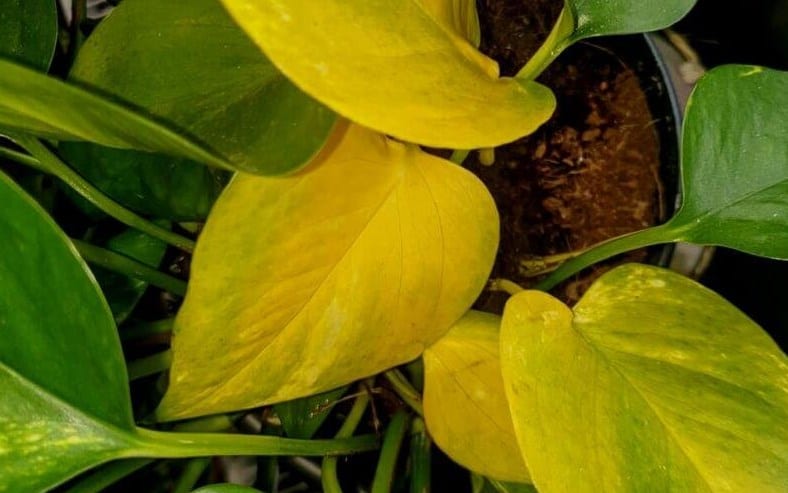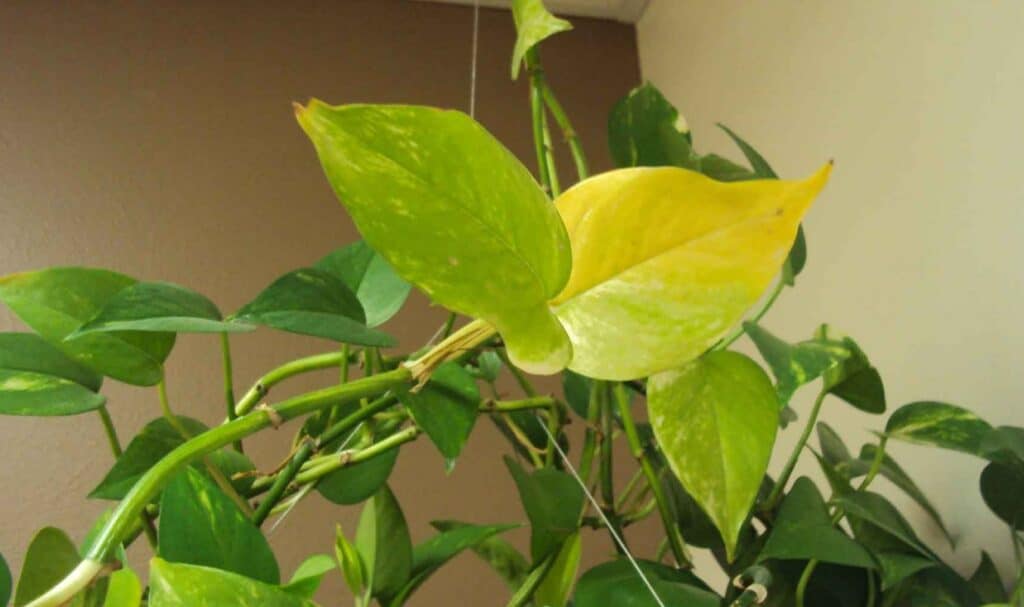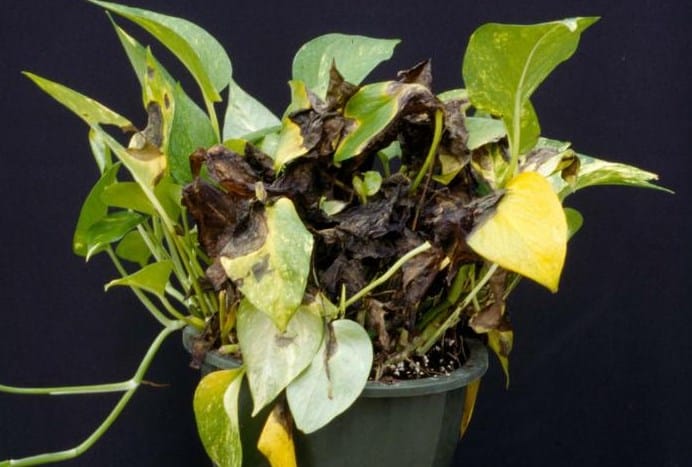- How to Propagate Monstera Guide: The Three Ways to Succeed - September 17, 2021
- Escargot Begonia: Why Is The Rex Begonia So Rare? - August 31, 2021
- Rieger Begonia: When You Can Expect The Hiemalis Begonia To Flourish - August 31, 2021
Nearly all varieties of Pothos plants are designated unfussy, forgiving, easygoing, and ideal for beginner gardeners. This, however, does not mean that these low-maintenance plants never face difficulties.
If you want to grow the best-looking and healthiest Pothos plants possible, it is a good idea to learn all about what issues they face, how to recognize and diagnose symptoms of an unhealthy plant, and of course, how to treat those issues. With this as our goal, let’s begin learning about yellowing leaves and how to treat them.
Identifying the Reasons for Yellow Leaves
There are four main factors that play into the health or lack thereof in the life of a Pothos plant. We’re going to thoroughly examine how each of these factors can cause a Pothos plant to have yellow leaves and what can be done about it.
Age

When Pothos plants mature, they are certainly going to lose leaves that are old. The old leaves will typically turn yellow before they completely detach from the plant. This is a normal and natural process that should not be a cause for concern. If your plant is old enough to shed leaves, simply remove the leaves as they turn yellow or fall off.
New leaves should continue to grow as the old leaves are removed, but if this is not happening, you may be facing a different issue. Keep reading if you feel that your plant’s yellow leaves may not be a sign that it is going through a normal aging process.
Nutrients
Plants that have recently been fertilized or have been watered with tap water may have yellow leaves because of nutrient build-up in their soil. Yellow leaves are also a sign that plants may not have enough nutrients in their soil.
Let’s take a thorough look at each of the possible diagnoses for a plant dealing with nutrient issues to determine what could be the cause of your plant’s yellow leaves, and then, let’s talk about how to treat them.
Over Fertilization
Part of determining whether or not this is the reason for the yellow leaves on your plant is to determine how long ago you fertilized your plant. If it has been recently fed, this is definitely an option to consider. Symptoms of this issue will include yellow leaves, but will also include leaves that have browned and burnt spots on them.
If you suspect that your Pothos plant has been over-fertilized, then the best way to treat it is to flush its soil with plenty of water. This process may require repetition, and if so, the soil should be allowed to dry out in between watering sessions.
Nutrient Deficiency

On the other side of the nutrient spectrum is a plant that needs more fertilizer in its soil. A plant in this state will have a variety of symptoms, each of which will indicate the nutrient it is lacking.
- A plant deficient in magnesium will feature leaves that are green in the middle but yellow on their edges.
- A plant deficient in iron, manganese, or zinc will feature leaf veins that are green while the rest of the leaf is yellow.
- A plant deficient in nitrogen will feature leaves that are yellow on its bottoms.
- A plant deficient in sulfur will feature leaves that are yellow on its tops.
To treat a Pothos plant that is facing any kind of nutrient deficiency, provide it with a few feedings of worm compost.
Nutrient Build Up
This happens when a plant is given water directly from the tap without allowing the excess minerals time to evaporate. A nutrient build-up in a plant may take a long time to develop but the treatments for it can begin immediately.
If you notice that your plant has yellow leaves and you have eliminated other sources for them, try watering your plant with distilled water or rainwater. It is also possible to set out tap water for 24 hours before giving it to your plant so that minerals in the water have time to evaporate. By lessening the number of minerals in your plant’s water, you may be able to cure your plant.
Sunlight
Pothos plants do not require hours of full sunlight. If they are set in direct sunlight for very long, their delicate leaves will burn. For this reason, many plant owners tend to set Pothos plants in dark corners of their home or garden space and assume that they will grow just fine without much sunlight at all. This, however, is not a correct assumption.
These plants should be set in a place that gets plenty of bright but indirect sunlight. This type of sunlight will improve the growth, health, and color of any Pothos variety. Without sunlight, the leaves of these plants will wither and turn to a pale and unhealthy shade of yellow.
If you’re unsure whether or not your Pothos plant is getting the appropriate amount of sunlight, test your indoor light with either a light meter or a light meter app, and then, check the results against a guide for indoor plant lighting. Once you realize where your Pothos plant will receive bright but indirect light, move it to that spot and watch it flourish.
Water
Water plays a major role in the health and vitality of all plants, and unfortunately, yellow leaves are a sign of both an over-watered and an under-watered plant. There are, however, a few other key symptoms that can help determine whether a plant needs more water or less. Let’s take some time to examine what each of these watering problems can lead to.
An Over Watered Plant

This is actually a far worse issue than an underwatered plant. An overwatered plant can lead to root rot, which if not treated properly, will eventually lead to the death of the plant. Combined with yellow leaves, look for these other signs of an overwatered Pothos plant:
- Leaves with brown spots
- Leaves that are curled
- Leaves that are mushy
- Leaves that smell like mildew
- Leaves that are translucent
- Leaves that are wilting
- Leaves that are wrinkled
- Roots that are brown and mushy
- Soil that is moldy
- Soil that has pests crawling in and on it
- Stems that are mushy
Treating an overwatered Pothos plant will take some time and effort. These treatments should be started as soon as possible in order to save the plant. If the plant is worth your time and effort, follow these steps:
- Assess the Damage
If the plant has just begun to show signs of being overwatered, you will only need to let it and its soil dry out for a few weeks. If, however, the symptoms are severe, you will need to apply a few more treatment methods to fix the problem.
Provide Drainage
Make sure that your Pothos plant is set in soil that is well-draining and in a plant container that has drainage holes.
Spray Fungicide
Rid your plant of mold and fungal infections, which can cause more damage, by applying a fungicide to it.
Treat the Soil Directly
Provide more aeration to the plant’s soil by stirring it. If this is not enough, remove the plant from its current soil and transplant it to fresh, dry soil.
Trim the Damage
Carefully cut off leaves, stems, and roots that have been damaged. They will fall off anyway, so, it is best to get them before they begin to rot and cause fungal infections. Remember to use clean and sterile cutting utensils.
An Under Watered Plant
Unlike an overwatered Pothos plant, an underwatered plant is easy to detect and treat. Besides yellow leaves, this issue will produce the following symptoms:
- Leaves that are crisp
- Leaves that are curled
- Leaves that are withered
- Leaves that are limp
To treat this issue, simply give the plant a nice drink.
Preventive Measures
When it comes to watering any plant, it is best to learn what each plant needs and how to best provide it. The following is a list of guidelines for how to water a Pothos plant. If you follow these, you should not have to deal with very many issues, including yellow leaves.
What to Avoid:
- Avoid watering the leaves of Pothos plants
- Avoid watering a Pothos plant that is sitting in soggy soil
- Avoid keeping Pothos plant in drought-like conditions
- Avoid watering a Pothos plant during the hottest times of the day
What to Do:
- Water a Pothos plant either early in the morning or when it gets cool in the evening
- Water a Pothos plant from the bottom up if you can’t avoid its leaves
- Water a Pothos deeply so that excess water flows out of its container’s drainage holes
- Allow the Pothos time to drain off excess water before setting it on a saucer
- Only water a Pothos when the top 50% of its soil is dry to the touch
- Use a plant watering app to ensure that you remember when and how to water your Pothos plant
FAQs
Question: Is There a Certain Type of Soil that Pothos Plants Should be Set In?
Answer: Yes, the soil is vitally important to the health of every type of plant, especially Pothos varieties. When it comes to selecting potting soil for your Pothos, you can either purchase a premade bag of potting soil, such as Devils Ivy Potting Soil, or you can make your own. To make your own potting soil, just combine the following ingredients:
• Peat moss (4 parts)
• Perlite or charcoal (2 parts)
• Vermiculite (1 part)
• Shredded bark (1 part)
Remember to pay attention to the pH levels of your soil as well. Pothos plants prefer pH levels that range between 6.1 and 6.5. Use a Soil pH Meter to test your soil’s pH levels and to learn which direction they should be adjusted in. For a more detailed look at how to adjust soil pH levels, read this article.
Question: Should Pothos Plants be Clustered Together With Other Plants?
Answer: Absolutely, yes. Clustering tropical plants together provide all the plants with extra humidity, which is what tropical plants require. When you search for a plant companion for your Pothos plant, keep the following factors in mind:
• Search for a companion planting that has similar needs, e.g., the same type of soil and watering method
• Search for a companion planting that is easy to grow
• Search for a companion planting with features that will complement your Pothos plant
Question: Are All Varieties of Pothos Plants Toxic?
Answer: Unfortunately, yes. This is why it is recommended that these plants be kept away from pets and small children. It is opportune that these are vining plants that grow extremely well in hanging planters, which is an optimal way to prevent your children and pets from getting into them.
If a child or pet has consumed one of these plants, call a medical professional or poison control immediately.
• Poison Control Center
• Animal Poison Control
• Ask a Poison Control Vet
Question: Where Can I Purchase Pothos Plants Online?
Answer: There are a lot of wonderful garden supply shops online, but the following shops have great reviews and great selections of Pothos plants.
• Amazon
• Woodies Garden Goods
• Etsy
Question: Which USDA Hardiness Zone Can Pothos be Planted In?
Answer: Pothos plants can be planted in a ground plot in zones 10 through 12. If you do not live within this range, you will need to plant your Pothos in a transportable container that can be brought indoors during cold and rainy weather.
Question: What Temperatures and Humidity Levels Should Pothos be Kept In?
Answer: These are tropical plants so they do enjoy a lot of heat and a lot of humidity. Pothos should be kept within a temperature range of 65 and 75 degrees Fahrenheit with humidity levels of at least 50%. If you want to care for your plants in this regard but don’t want to create the feel of a greenhouse in your home, consider purchasing these items:
• Plant Heat Mat for extra heat
• Pebble tray or Plant Humidifier for extra humidity
Pothos Leaves Turning Yellow Troubleshooting: Conclusion
Pothos plants are one of the best houseplants available. They are full of variety in shape, size, and color variegation, but best of all, they are low-maintenance. Once you learn some of their quirks and some of the possible issues they experience, you will be well on your way to growing a beautiful and successful Pothos garden.

